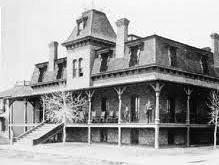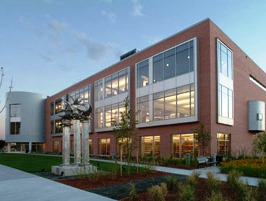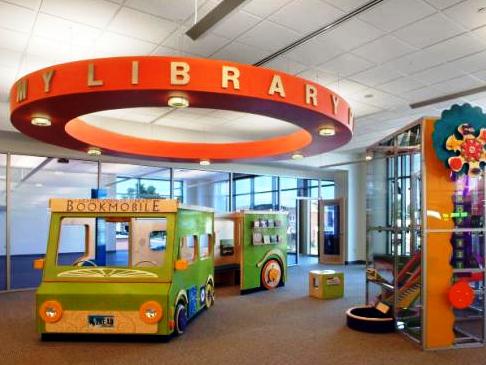» posted on Monday, September 17th, 2012 by Linda Lou Burton
First and Foremost
 Linda Burton posting from Cheyenne, Wyoming – Wyoming may be the 50th state in terms of population, but it lays claim to an awful lot of FIRSTS. It is home to the first National Park in the United States (in fact, the world). The beloved Yellowstone National Park, in the northwest corner of the state, was created by an act of Congress in 1872. Wyoming also has the first National Monument – Devils Tower, in the northeast corner of the state; designated by President Theodore Roosevelt in 1906. The first National Forest – the Shoshone – and the first ranger station – the Wapiti, in that forest – were created in 1891. The first business west of the Missouri River was established by fur traders William Sublette and Robert Campbell in 1834, near Fort William in Wyoming. And Wyoming was the first state to have a county public library system. The Laramie County Library was established in 1886, when Wyoming was still a territory. Located in the capital city of Cheyenne and still in existence today, it is the longest continually operating county library system in the United States.
Linda Burton posting from Cheyenne, Wyoming – Wyoming may be the 50th state in terms of population, but it lays claim to an awful lot of FIRSTS. It is home to the first National Park in the United States (in fact, the world). The beloved Yellowstone National Park, in the northwest corner of the state, was created by an act of Congress in 1872. Wyoming also has the first National Monument – Devils Tower, in the northeast corner of the state; designated by President Theodore Roosevelt in 1906. The first National Forest – the Shoshone – and the first ranger station – the Wapiti, in that forest – were created in 1891. The first business west of the Missouri River was established by fur traders William Sublette and Robert Campbell in 1834, near Fort William in Wyoming. And Wyoming was the first state to have a county public library system. The Laramie County Library was established in 1886, when Wyoming was still a territory. Located in the capital city of Cheyenne and still in existence today, it is the longest continually operating county library system in the United States.
 Cheyenne, Wyoming. Now the northern edge of the fast-growing Front Range Urban Corridor, Cheyenne started out rough, a site chosen as the point where the Union Pacific Railroad would cross Crow Creek. It was platted out in 1867 by General Grenville Dodge and his survey crew; the first tents were pitched on July 4. The first residents were “railroad men;” many moved away when construction was completed in November, on their way across the country as the building of the railroad moved towards Promontory Point, Utah to meet the eastward-building Central Pacific. Those who stayed were railroad gangs, soldiers from Fort Russell, and employees from Camp Carlin, a supply camp for northern posts on the Indian front.
Cheyenne, Wyoming. Now the northern edge of the fast-growing Front Range Urban Corridor, Cheyenne started out rough, a site chosen as the point where the Union Pacific Railroad would cross Crow Creek. It was platted out in 1867 by General Grenville Dodge and his survey crew; the first tents were pitched on July 4. The first residents were “railroad men;” many moved away when construction was completed in November, on their way across the country as the building of the railroad moved towards Promontory Point, Utah to meet the eastward-building Central Pacific. Those who stayed were railroad gangs, soldiers from Fort Russell, and employees from Camp Carlin, a supply camp for northern posts on the Indian front.
 By 1869 every other building in town was a saloon, and five “variety” theaters were in operation, with plenty of female performers. But Cheyenne didn’t remain rowdy for long; the railroad that started it all continued to affect its development. The Union Pacific also brought in some great entertainment; the opera house was built in 1882 and performers such as Lily Langtry and Emma Nevada and their troupes stopped in on their way to San Francisco.
By 1869 every other building in town was a saloon, and five “variety” theaters were in operation, with plenty of female performers. But Cheyenne didn’t remain rowdy for long; the railroad that started it all continued to affect its development. The Union Pacific also brought in some great entertainment; the opera house was built in 1882 and performers such as Lily Langtry and Emma Nevada and their troupes stopped in on their way to San Francisco.
Because the railroad also provided direct access to the East, Cheyenne got the most recently published magazines and newspapers, the latest styles in furniture, and the most fashionable apparel. Eastern cultural ideals were transported to Cheyenne via railroad and by 1875 the population of 5,000 enjoyed a social life on par with many cities in the East.
 The cattle industry was another factor in Cheyenne’s development. Purebred Hereford cattle were raised at the famous Wyoming Hereford Ranch near Cheyenne as early as 1880. The town attracted wealthy men from the East and Europe; many were graduates of the most outstanding universities in England and America. Cattle barons summered in Cheyenne and wintered in Europe; the world-famous Cheyenne Club was established. Lavishly furnished like an English club, it had a large dining room, a lounge, card rooms, and a reading room.
The cattle industry was another factor in Cheyenne’s development. Purebred Hereford cattle were raised at the famous Wyoming Hereford Ranch near Cheyenne as early as 1880. The town attracted wealthy men from the East and Europe; many were graduates of the most outstanding universities in England and America. Cattle barons summered in Cheyenne and wintered in Europe; the world-famous Cheyenne Club was established. Lavishly furnished like an English club, it had a large dining room, a lounge, card rooms, and a reading room.
The stage was set for that FIRST county library system in the country.
Territorial citizens of Cheyenne rallied for five years to fund the library, which opened in 1886. It was located on the third floor of a business building on Carey Avenue. When Wyoming became a state in 1890, state statute dictated that library service be provided for its residents by the county government. In 1899 Andrew Carnegie donated $50,000 towards a new building, and three years later the Laramie County Library on Capitol Avenue opened, with 10,000 square feet of space.
 Many years and several buildings later, the newest version opened in 2007, with 100,000 square feet of space; it’s a major award-winning community destination. There are five community meeting rooms and eight study rooms; a 50-station computer center with training classroom; a community “living room” that is a quiet reading area; the Loft for teens and My Library Place for children; and of course a fabulous collection of books, audiobooks, movies, and music.
Many years and several buildings later, the newest version opened in 2007, with 100,000 square feet of space; it’s a major award-winning community destination. There are five community meeting rooms and eight study rooms; a 50-station computer center with training classroom; a community “living room” that is a quiet reading area; the Loft for teens and My Library Place for children; and of course a fabulous collection of books, audiobooks, movies, and music.
The Laramie County Library was named Library of the Year by Library Journal in 2008, and listed as a Top Ten Destination Library by Nancy Pearl in USA Today. But one of the most remarkable achievements for the building is its Gold Certification for Leadership in Energy and Environmental Design (LEED). It is the first LEED certified public building in Wyoming.
In addition to the library in Cheyenne, there are branches in Pine Bluffs and Burns. And oh yes, they still have bookmobiles, just like back in 1886.
Laramie County Library http://www.lclsonline.org/

